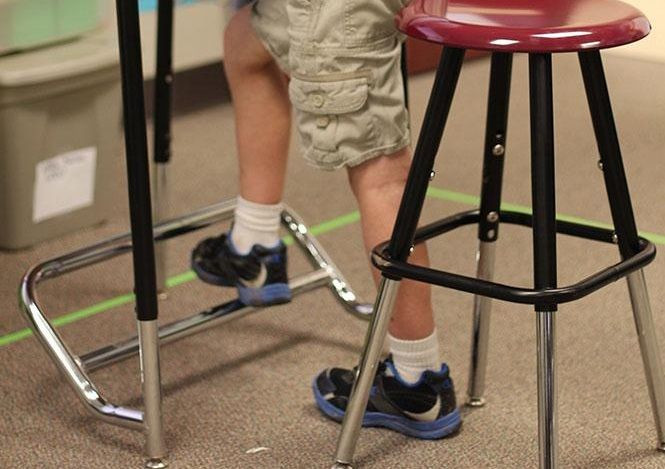Standing Desks May Fight Childhood Obesity And Improve Attention Span In School

Kids today don’t seem to be as interested in going outside and playing as they are in staring at a blue-lit piece of glass and metal. Who could blame them? Their friends are all inside doing the same thing and probably stuffing fistfuls of Cheetos into their mouths while they do it.
Of course, these unhealthy behaviors are destructive in more ways than one. Growing bodies of research continue to uphold the idea that a person’s brain and body are connected, at least in the sense that food and activity levels can fuel, or stall, cognition. Now engineers from Texas A&M University have found the seven-hour stretch of time kids spend at school is ripe for offsetting the downsides of sitting at home doing nothing.
Standing desks have been around since at least the 18th century, but their prominence in American office spaces has only recently taken hold. They tend to sprout like spring flowers (or weeds, depending on whose head you see all day), and their health benefits have been dissected time and again. Dr. Mark Benden, associate professor at the Texas A&M Health Science Center School of Public Health, wondered: Could kids reap the same benefits at school?
“Considerable research indicates that academic behavioral engagement is the most important contributor to student achievement,” Benden said in a press release. When kids sit at a desk all day, they don’t have to use any energy, which means they can just as easily fall asleep, daydream, or distract themselves by distracting others. Giving them the choice to stand up, Benden says, could help keep their brains and bodies busy. “Simply put, we think better on our feet than in our seat.”
He and his team reached that conclusion by studying how well 282 second-, third-, and fourth-graders paid attention in class when they were given stand-biased desks. They weren’t full standing desks, but rather gave kids the option whether to sit on a stool or stand. Overall, the students who spent the fall and spring semesters in the experimental group were between 12 and 25 percent more engaged than the control group. On average, this worked out to an extra seven minutes of concentrated work per hour.
Benden has visions of implementing the standing desk classroom all around the country. It yields a positive peer-pressure effect, he says. Kids who use the desk frequently are more likely to inspire other kids to get off their backsides. “We know we’re at historical highs as far as the epidemic of childhood obesity,” Benden told Medical Daily. Standing desks could get kids out of their seats and dynamically engaged with their work. Although, standing per se isn’t the intended solution. “The solution is movement,” he said.
That goal has some built-in limitations. Not all kids will spend their school days in constant motion, which means many are apt to stand in place with poor posture and develop pain in their lower backs and feet. The best-case scenario, Benden says, is that after several weeks of use the kids will develop the necessary core strength to support the weight of their own skeleton. But if standing is simply too tiring, they always have the option to sit down.
Solving childhood obesity needs more than standing desks — that much Benden concedes. Kids, like the rest of the American population, need a mixture of physical activity and healthy food choices. Standing desks could offer a unique advantage to other forms that have started lacking, such as physical education and recess, both of which have seen declines in rigor and accessibility over the last several years. Importantly, says Benden, standing desks resolve any tension between the needs of kids of different sexes and socioeconomic backgrounds.
“It’s really nice to have something in the classroom, available to all children to take advantage of equally, and get an equal benefit from,” he said. “And that to me is just a huge, huge positive of this approach.”
Source: Dornhecker, M, Blake J, Benden M, Zhao H, Wendel M. The effect of stand-biased desks on academic engagement: an exploratory study. International Journal of Health Promotion and Education. 2015.
Published by Medicaldaily.com



























